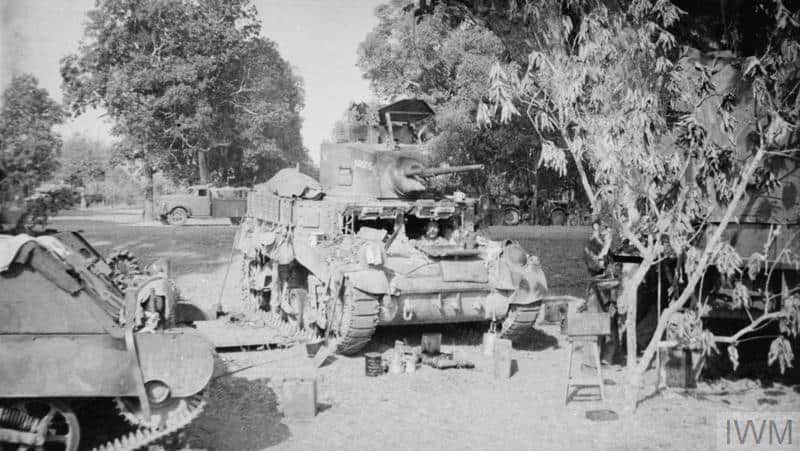Pegu, 1942
This action was fought by the 48th Indian Brigade Group, during the withdrawal from Rangoon. Fierce hand-to-hand fighting took place at roadblocks.
The Honour was emblazoned by the 7th Hussars.
Paungde
In this offensive Action, undertaken to help relieve pressure on the Chinese 5th Army, ‘Anstice Column’ (the equivalent of a brigade group) occupied Padigaon and Wetpok but failed to capture Paungde, though inflicting considerable losses on the enemy.
The Honour was emblazoned by the 7th Hussars.
Detail
The 7th Hussars were the only British cavalry regiment to fight in Burma and landed with the 7th Armoured Brigade on the 21st of February 1942 at Rangoon.
The situation was desperate and the 7th Hussars moved straight up to Pegu to fight the marauding Japanese.
‘B’ Squadron of the 7th Hussars, Maj. G. C. Davies-Gilbert commanding, arrived in the village of Payagyi to find the Japanese already there. Visibility was poor, and radio communication was difficult.
After a brief infantry engagement, the Stuart light tanks opened fire, destroying two Type 95 Ha-Go Japanese tanks. A confused battle ensued, in which two more Type 95s were destroyed, another Type 95 was abandoned by its crew, and four Japanese anti-tank guns were captured.
Then the order came for the British to move to Hlegu.
Hlegu was also in Japanese hands as the British approached. The Japanese had erected a roadblock, and they defended it with Molotov cocktails, knocking out one of the tanks. In the end, they were forced to retreat in the face of heavy fire from the tanks.
The 7th Hussars’ Regimental Chaplain, the Revd Neville Metcalfe, was awarded an immediate Distinguished Service Order for his actions in helping the British wounded, and conducting burial services for the dead, despite being wounded by mortar fire.
Pegu was untenable so the British began their historic retreat northwards using their Stuart tanks to smash roadblocks, cover the withdrawal and carry the wounded.
There were countless acts of heroism by the 7th Hussars in the face of the inhumanity of the Japanese, and epitomised in Field Marshall Alexander’s words about the 7th Hussars:
“Without them, we should never had got the Army out of Burma; no praise can be too high for them”
Why not discover the kind of night Capt Patteson had during this telling time?
Soon the British had been pushed back beyond Prome and at the start of May 1942 when they crossed the river Chindwin, the regiment had to destroy their tanks and became pedestrians for the final 150 miles of the retreat.
On the 17th of May, the remnants of the division staggered into Imphal.
The 7th Hussars had covered nearly one thousand miles in three and half months losing forty-six killed and fifty wounded, and earning the highest regard from all who had met them.


